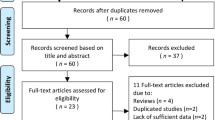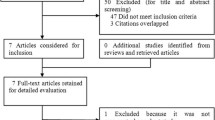Abstract
Purpose
Versican regulates adhesion, migration, proliferation, and survival of cells, and plays an important role in cancer development. A case–control association study was performed to test genetic association of versican polymorphisms with susceptibility to gastric cancer.
Methods
In this study, 1,101 unrelated Korean subjects including 612 gastric cancer patients and 489 healthy controls were genotyped for all 21 exonic polymorphisms in the versican gene (VCAN) encoding amino acid changes in versican. Cancer susceptibility associations with the polymorphisms were assessed using multivariate logistic regression analysis with adjustment for age and gender and with control for multiple testing.
Results
Two amino acid changes in GAG-β domain of versican encoded by two almost fully correlated (r 2 = 0.97) nonsynonymous single-nucleotide polymorphisms in VCAN were associated with gastric cancer. The association was evident in intestinal-type but not in diffuse-type gastric cancer. The minor-allele homozygote of rs188703 (G > A, R1826H) or rs160277 (G > T, D2937Y) was significantly associated with a twofold decreased susceptibility to intestinal-type gastric cancer when compared with the other genotypes (adjusted odds ratio = 0.52 or 0.51, P = 0.0098 or 0.0087, respectively).
Conclusions
The intestinal-type gastric cancer susceptibility is associated with two amino acid changes of versican in the GAG-β domain, which is critical for enhancement of cell proliferation and activation of EGFR signal pathway by versican, and changes from the major to minor alleles may impair the function to decrease susceptibility to cancer.

Similar content being viewed by others
Abbreviations
- CI:
-
Confidence interval
- GAG:
-
Glycosaminoglycan
- LD:
-
Linkage disequilibrium
- OR:
-
Odds ratio
- SNP:
-
Single-nucleotide polymorphism
References
Barrett JC, Fry B, Maller J, Daly MJ (2005) Haploview: analysis and visualization of LD and haplotype maps. Bioinformatics 21:263–265
Boussioutas A, Li H, Liu J, Waring P, Lade S, Holloway AJ, Taupin D, Gorringe K, Haviv I, Desmond PV, Bowtell DD (2003) Distinctive patterns of gene expression in premalignant gastric mucosa and gastric cancer. Cancer Res 63:2569–2577
Brown LF, Guidi AJ, Schnitt SJ, Van De Water L, Iruela-Arispe ML, Yeo TK, Tognazzi K, Dvorak HF (1999) Vascular stroma formation in carcinoma in situ, invasive carcinoma, and metastatic carcinoma of the breast. Clin Cancer Res 5:1041–1056
Cattaruzza S, Schiappacassi M, Kimata K, Colombatti A, Perris R (2004) The globular domains of PG-M/versican modulate the proliferation-apoptosis equilibrium and invasive capabilities of tumor cells. FASEB J 18:779–781
Dours-Zimmermann MT, Zimmermann DR (1994) A novel glycosaminoglycan attachment domain identified in two alternative splice variants of human versican. J Biol Chem 269:32992–32998
Evanko SP, Angello JC, Wight TN (1999) Formation of hyaluronan- and versican-rich pericellular matrix is required for proliferation and migration of vascular smooth muscle cells. Arterioscler Thromb Vasc Biol 19:1004–1013
Hippo Y, Taniguchi H, Tsutsumi S, Machida N, Chong JM, Fukayama M, Kodama T, Aburatani H (2002) Global gene expression analysis of gastric cancer by oligonucleotide microarrays. Cancer Res 62:233–240
Kim SY, Kim JH, Lee HS, Noh SM, Song KS, Cho JS, Jeong HY, Kim WH, Yeom YI, Kim NS, Kim S, Yoo HS, Kim YS (2007) Meta- and gene set analysis of stomach cancer gene expression data. Mol Cells 24:200–209
Landolt RM, Vaughan L, Winterhalter KH, Zimmermann DR (1995) Versican is selectively expressed in embryonic tissues that act as barriers to neural crest cell migration and axon outgrowth. Development 121:2303–2312
LaPierre DP, Lee DY, Li SZ, Xie YZ, Zhong L, Sheng W, Deng Z, Yang BB (2007) The ability of versican to simultaneously cause apoptotic resistance and sensitivity. Cancer Res 67:4742–4750
Lemire JM, Merrilees MJ, Braun KR, Wight TN (2002) Overexpression of the V3 variant of versican alters arterial smooth muscle cell adhesion, migration, and proliferation in vitro. J Cell Physiol 190:38–45
Menashe I, Rosenberg PS, Chen BE (2008) PGA: power calculator for case-control genetic association analyses. BMC Genet 9:36
Paulus W, Baur I, Dours-Zimmermann MT, Zimmermann DR (1996) Differential expression of versican isoforms in brain tumors. J Neuropathol Exp Neurol 55:528–533
Ramensky V, Bork P, Sunyaev S (2002) Human non-synonymous SNPs: server and survey. Nucleic Acids Res 30:3894–3900
Ricciardelli C, Brooks JH, Suwiwat S, Sakko AJ, Mayne K, Raymond WA, Seshadri R, LeBaron RG, Horsfall DJ (2002) Regulation of stromal versican expression by breast cancer cells and importance to relapse-free survival in patients with node-negative primary breast cancer. Clin Cancer Res 8:1054–1060
Sakko AJ, Ricciardelli C, Mayne K, Tilley WD, Lebaron RG, Horsfall DJ (2001) Versican accumulation in human prostatic fibroblast cultures is enhanced by prostate cancer cell-derived transforming growth factor beta1. Cancer Res 61:926–930
Schmalfeldt M, Dours-Zimmermann MT, Winterhalter KH, Zimmermann DR (1998) Versican V2 is a major extracellular matrix component of the mature bovine brain. J Biol Chem 273:15758–15764
Serrano M, Massague J (2000) Networks of tumor suppressors. Workshop: tumor suppressor networks. EMBO Rep 1:115–119
Sheng W, Wang G, Wang Y, Liang J, Wen J, Zheng PS, Wu Y, Lee V, Slingerland J, Dumont D, Yang BB (2005) The roles of versican V1 and V2 isoforms in cell proliferation and apoptosis. Mol Biol Cell 16:1330–1340
Sheng W, Wang G, La Pierre DP, Wen J, Deng Z, Wong CK, Lee DY, Yang BB (2006) Versican mediates mesenchymal–epithelial transition. Mol Biol Cell 17:2009–2020
Stephens M, Donnelly P (2003) A comparison of Bayesian methods for haplotype reconstruction from population genotype data. Am J Hum Genet 73:1162–1169
Stephens M, Smith NJ, Donnelly P (2001) A new statistical method for haplotype reconstruction from population data. Am J Hum Genet 68:978–989
Theocharis AD (2008) Versican in health and disease. Connect Tissue Res 49:230–234
Touab M, Villena J, Barranco C, Arumi-Uria M, Bassols A (2002) Versican is differentially expressed in human melanoma and may play a role in tumor development. Am J Pathol 160:549–557
Wight TN (2002) Versican: a versatile extracellular matrix proteoglycan in cell biology. Curr Opin Cell Biol 14:617–623
Wight TN, Merrilees MJ (2004) Proteoglycans in atherosclerosis and restenosis: key roles for versican. Circ Res 94:1158–1167
Wu Y, Wu J, Lee DY, Yee A, Cao L, Zhang Y, Kiani C, Yang BB (2005) Versican protects cells from oxidative stress-induced apoptosis. Matrix Biol 24:3–13
Yang BL, Zhang Y, Cao L, Yang BB (1999) Cell adhesion and proliferation mediated through the G1 domain of versican. J Cell Biochem 72:210–220
Yee AJ, Akens M, Yang BL, Finkelstein J, Zheng PS, Deng Z, Yang B (2007) The effect of versican G3 domain on local breast cancer invasiveness and bony metastasis. Breast Cancer Res 9:R47
Zhang Y, Cao L, Yang BL, Yang BB (1998) The G3 domain of versican enhances cell proliferation via epidermial growth factor-like motifs. J Biol Chem 273:21342–21351
Zheng PS, Wen J, Ang LC, Sheng W, Viloria-Petit A, Wang Y, Wu Y, Kerbel RS, Yang BB (2004) Versican/PG-M G3 domain promotes tumor growth and angiogenesis. FASEB J 18:754–756
Acknowledgments
We appreciate Kyu-Sang Song for assistance in sample collection and Yikyeong Kim for technical and administrative assistance. This work was supported by grants from the Korea Healthcare Technology R&D Project [A084417]. H. Ju, B. Lim, M. Kim, and C. Kang are participants to the Brain Korea 21 Program. The sponsors had no role in design, performance or writing of the study.
Author information
Authors and Affiliations
Corresponding author
Rights and permissions
About this article
Cite this article
Ju, H., Lim, B., Kim, M. et al. Genetic variants A1826H and D2937Y in GAG-β domain of versican influence susceptibility to intestinal-type gastric cancer. J Cancer Res Clin Oncol 136, 195–201 (2010). https://doi.org/10.1007/s00432-009-0647-8
Received:
Accepted:
Published:
Issue Date:
DOI: https://doi.org/10.1007/s00432-009-0647-8




